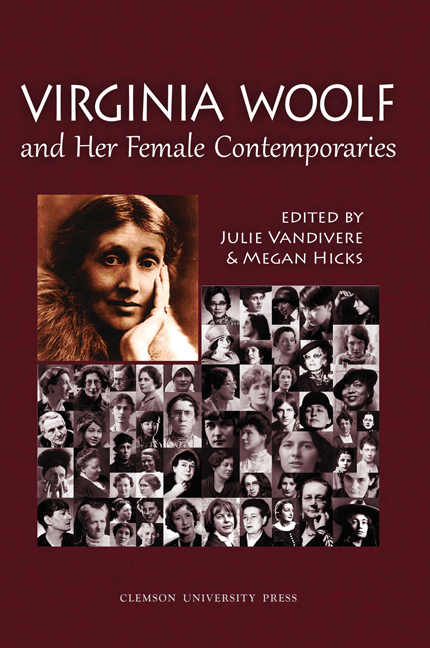Book contents
- Frontmatter
- Table of Contents
- Introduction
- Acknowledgments
- Abbreviations
- Who Are Virginia Woolf's Female Contemporaries?
- Virginia Woolf's Cultural Contexts
- Virginia Woolf's Contemporaries Abroad
- Reconfiguring the Mermaid: HD, Virginia Woolf, and the Radical Ethics of Writing as Marine Practice
- A Carnival of the Grotesque: Feminine Imperial Flânerie in Virginia Woolf 's “Street Haunting” and Una Marson's “Little Brown Girl”
- Mad Women: Dance, Female Sexuality, and Surveillance in the Work of Virginia Woolf and Emily Holmes Coleman
- Shop My Closet: Virginia Woolf, Marianne Moore, and Fashion Contemporaries
- Virginia Woolf and Victoria Ocampo: A Brazilian Perspective
- Making Waves in Lonely Parallel: Evelyn Scott and Virginia Woolf
- Critical Characters in Search of an Author: Cornelia Sorabji and Virginia Woolf
- “In my mind I saw my mother”: Virginia Woolf, Zitkala-Ša, and Autobiography
- Virginia Woolf's Contemporaries at Home
- Tribute to Jane Marcus
- Notes on Contributors
- Conference Program 223
Shop My Closet: Virginia Woolf, Marianne Moore, and Fashion Contemporaries
from Virginia Woolf's Contemporaries Abroad
- Frontmatter
- Table of Contents
- Introduction
- Acknowledgments
- Abbreviations
- Who Are Virginia Woolf's Female Contemporaries?
- Virginia Woolf's Cultural Contexts
- Virginia Woolf's Contemporaries Abroad
- Reconfiguring the Mermaid: HD, Virginia Woolf, and the Radical Ethics of Writing as Marine Practice
- A Carnival of the Grotesque: Feminine Imperial Flânerie in Virginia Woolf 's “Street Haunting” and Una Marson's “Little Brown Girl”
- Mad Women: Dance, Female Sexuality, and Surveillance in the Work of Virginia Woolf and Emily Holmes Coleman
- Shop My Closet: Virginia Woolf, Marianne Moore, and Fashion Contemporaries
- Virginia Woolf and Victoria Ocampo: A Brazilian Perspective
- Making Waves in Lonely Parallel: Evelyn Scott and Virginia Woolf
- Critical Characters in Search of an Author: Cornelia Sorabji and Virginia Woolf
- “In my mind I saw my mother”: Virginia Woolf, Zitkala-Ša, and Autobiography
- Virginia Woolf's Contemporaries at Home
- Tribute to Jane Marcus
- Notes on Contributors
- Conference Program 223
Summary
When Virginia Woolf asked Dorothy Bussy in 1936, “What did she wear?” in reference to Mary Hutchinson (Lee 6), she expressed the idea that one's identity, curiosity, and fashion anxiety exist in the context of a social community, particularly a female one. Indeed, several years earlier in June 1919, Woolf consigned herself to the community of “the badly dressed,” remarking, “I am resigned to my station among the badly dressed though Gravé [a dressmaker]…scarcely seem[s] to confirm that statement” (D1: 284). Articulating concern about how others would perceive her in terms of the ways clothing creates identity, Woolf went on to wonder about what she called the question of “aesthetic taste”: “Why am I calm & indifferent as to what people say of Night & Day, & fretful for their good opinion of my blue dress?” (D1: 284). Woolf 's well-documented fashion angst is read through the lens of fashion contemporaries like Marianne Moore, whose fashion (and literary) identity was supported by family and friends in a kind of female patronage. It is clear to me that whatever these female contemporaries felt about their relationship with clothes, they wanted to manage their self-presentation within society and in consideration of their art.
Keying on the idea of individuality, identity, and social relationships, I explore the extensive Moore Collection at The Rosenbach of the Free Library of Philadelphia to show how friendship can be negotiated within and through fashion. I argue that the support of Moore's circle enabled her to navigate (in effect “shop their closets”) and rise above the doubts that beset Woolf in what Cecil Beaton calls the “very private outward expression of themselves” (Beaton 7). I examine, briefly, how other modernist women, whom I call fashion contemporaries, link their friendships with fashion. Woolf 's troubled negotiations with dress and fashion show that the support of female contemporaries enabled a very different kind of self-construction.
In 1971, in a kind of fashion retrospective, Cecil Beaton organized an exhibition at the Victoria and Albert Museum to honor the “originals, from what little survived jumble sales, thrift shops, village pantomimes, or cast-offs to poor relations and impoverished governesses” (8).
- Type
- Chapter
- Information
- Virginia Woolf and Her Female Contemporaries , pp. 116 - 121Publisher: Liverpool University PressPrint publication year: 2016



